Analysis of a Case Study: Ulcerative Colitis Symptoms and Treatment
VerifiedAdded on 2023/04/11
|7
|1344
|228
Homework Assignment
AI Summary
This assignment presents a detailed case study of a patient, Eleanor, suffering from ulcerative colitis, specifically pancolitis, characterized by inflammation and ulcers in the colon and rectum. The analysis covers the patient's symptoms, including significant weight loss, loss of appetite, internal bleeding, and shortness of breath, along with associated physiological changes like hypotensive conditions and elevated ESR levels. The assignment explores the structural and functional changes contributing to the condition, such as food aversion, malabsorption, and hormonal imbalances. It also examines the pain pathways involved and the contraindications of certain medications like morphine. Furthermore, it discusses the treatment strategies, including the use of Hartmann's solution to manage dehydration and hypovolemia. The document provides a comprehensive overview of the disease, its effects, and the medical interventions employed to manage the patient's condition.
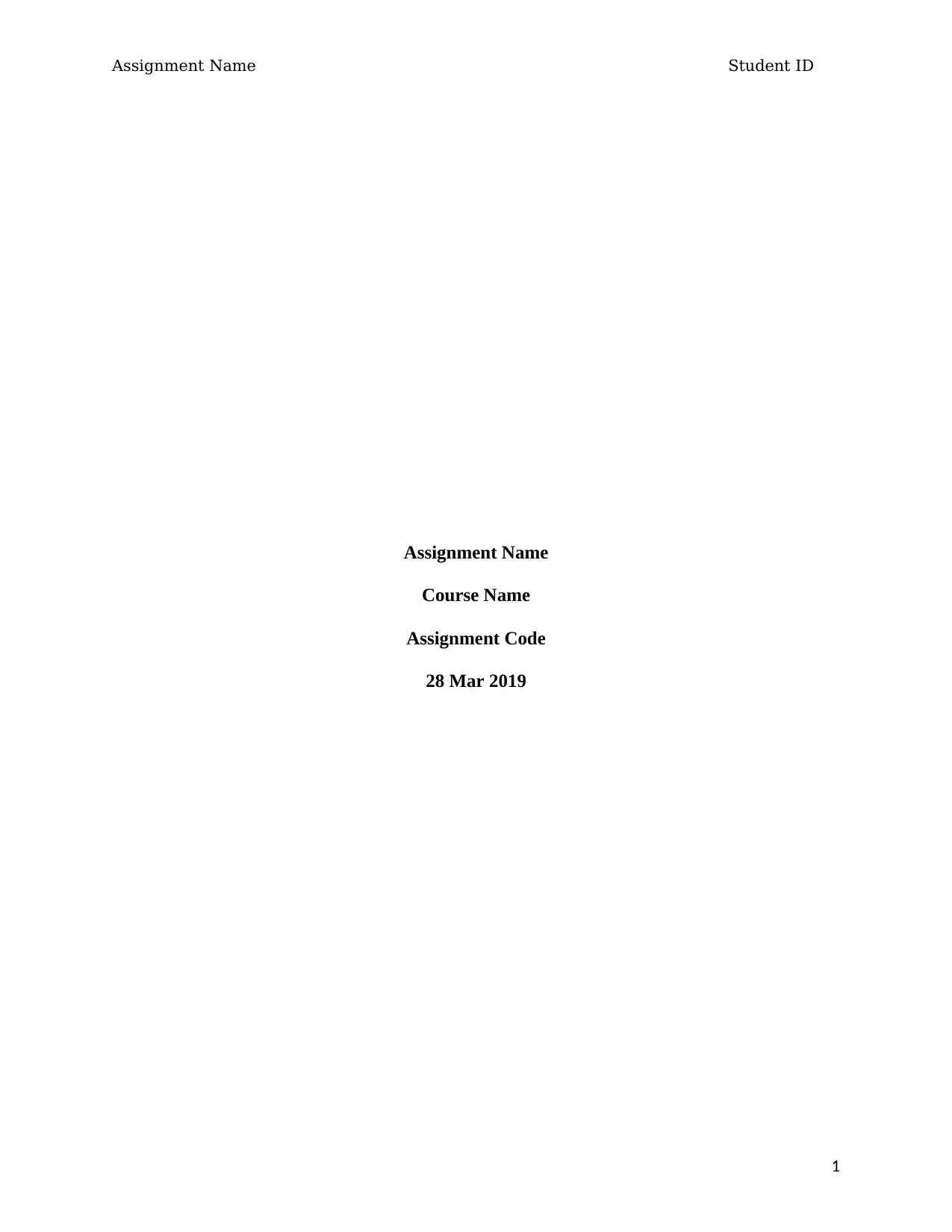
Assignment Name Student ID
Assignment Name
Course Name
Assignment Code
28 Mar 2019
1
Assignment Name
Course Name
Assignment Code
28 Mar 2019
1
Paraphrase This Document
Need a fresh take? Get an instant paraphrase of this document with our AI Paraphraser

Assignment Name Student ID
Answer 1:
In the present case, Eleanor is suffering from ulcerative colitis, which causes inflammation and
ulcers in the inner lining of the colon and rectum. As a result of which, the ulcers developed on
the inner lining male leads to bleeding and production of mucus. Further, according to the case
history, the inflammation affects the whole colon, and the condition is known as pancolitis. The
common symptoms associated with this condition include loss of appetite and weight loss. This
is reflected in the present clinical intervention, as Eleanor has lost 9 kg in the past two weeks.
According to a report, the indication of weight loss is because of malnutrition condition (Chiba,
Tsuda, Komatsu, Tozawa & Takayama, 2016). As such, the body is not getting efficient calories
to meet the routine requirement and thus results in significant weight loss.
Apart from appetite, other significant reasons for weight loss include structural changes
(inflammation), resulting in (Lemberg & Day, 2015):
Food aversion which causes nausea like symptom and gives inner feeling to avoid food
intake. Further, the aversion is also resulting due to the association of food eating with
pain.
Malabsorption of nutrients due to inflammation in the inner lining of the colon. This is
also affected because of disturbance in the gastrointestinal tract that leads to upset and
poor absorption.
Increase in utilization of calories by the body, in response to fighting the disease.
Loss of nutrients due to internal bleeding and diarrhea.
Functional changes - According to the report of Irwin, Raehtz, Parameswaran & McCabe (2016),
the pharmacological reason associated weight loss of appetite is linked with increased
2
Answer 1:
In the present case, Eleanor is suffering from ulcerative colitis, which causes inflammation and
ulcers in the inner lining of the colon and rectum. As a result of which, the ulcers developed on
the inner lining male leads to bleeding and production of mucus. Further, according to the case
history, the inflammation affects the whole colon, and the condition is known as pancolitis. The
common symptoms associated with this condition include loss of appetite and weight loss. This
is reflected in the present clinical intervention, as Eleanor has lost 9 kg in the past two weeks.
According to a report, the indication of weight loss is because of malnutrition condition (Chiba,
Tsuda, Komatsu, Tozawa & Takayama, 2016). As such, the body is not getting efficient calories
to meet the routine requirement and thus results in significant weight loss.
Apart from appetite, other significant reasons for weight loss include structural changes
(inflammation), resulting in (Lemberg & Day, 2015):
Food aversion which causes nausea like symptom and gives inner feeling to avoid food
intake. Further, the aversion is also resulting due to the association of food eating with
pain.
Malabsorption of nutrients due to inflammation in the inner lining of the colon. This is
also affected because of disturbance in the gastrointestinal tract that leads to upset and
poor absorption.
Increase in utilization of calories by the body, in response to fighting the disease.
Loss of nutrients due to internal bleeding and diarrhea.
Functional changes - According to the report of Irwin, Raehtz, Parameswaran & McCabe (2016),
the pharmacological reason associated weight loss of appetite is linked with increased
2
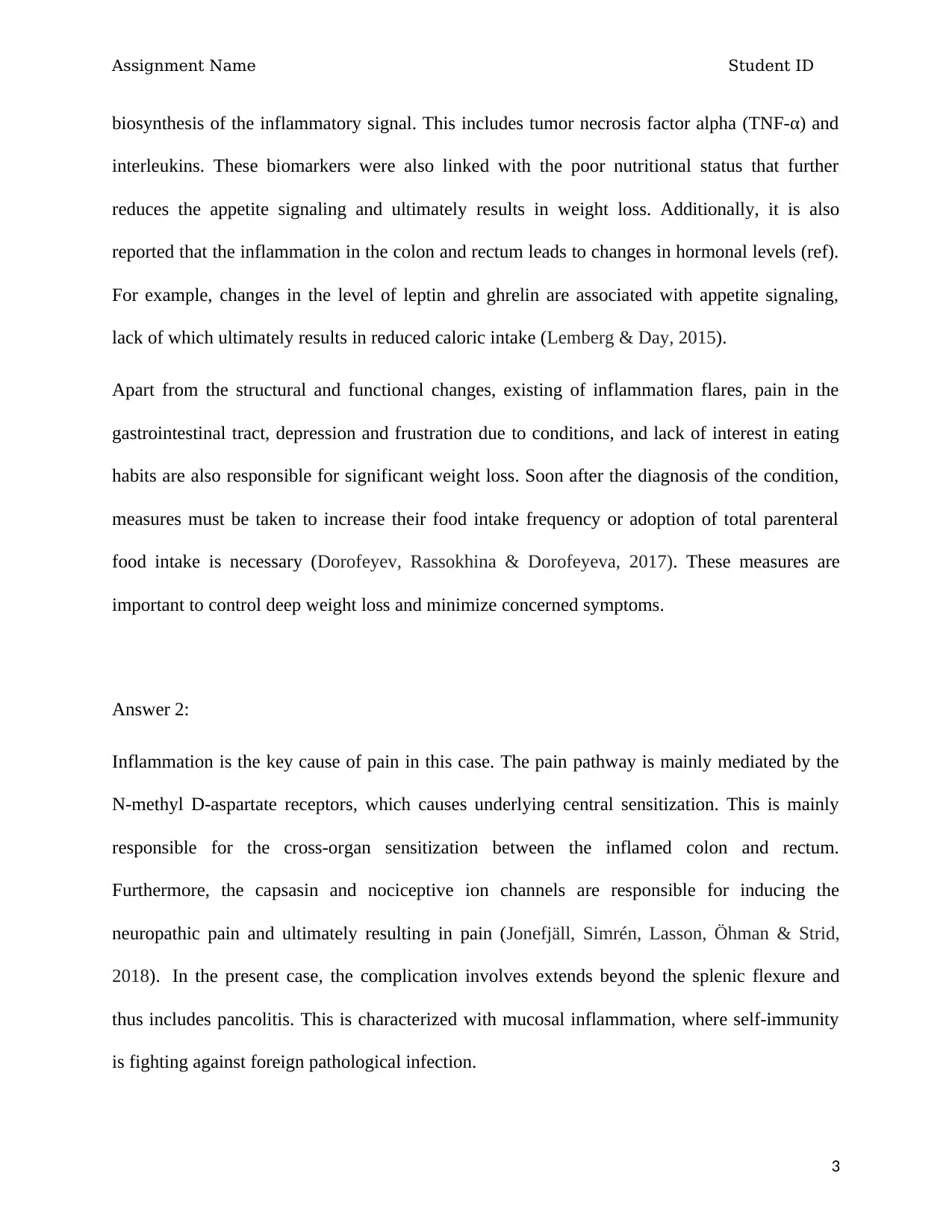
Assignment Name Student ID
biosynthesis of the inflammatory signal. This includes tumor necrosis factor alpha (TNF-α) and
interleukins. These biomarkers were also linked with the poor nutritional status that further
reduces the appetite signaling and ultimately results in weight loss. Additionally, it is also
reported that the inflammation in the colon and rectum leads to changes in hormonal levels (ref).
For example, changes in the level of leptin and ghrelin are associated with appetite signaling,
lack of which ultimately results in reduced caloric intake (Lemberg & Day, 2015).
Apart from the structural and functional changes, existing of inflammation flares, pain in the
gastrointestinal tract, depression and frustration due to conditions, and lack of interest in eating
habits are also responsible for significant weight loss. Soon after the diagnosis of the condition,
measures must be taken to increase their food intake frequency or adoption of total parenteral
food intake is necessary (Dorofeyev, Rassokhina & Dorofeyeva, 2017). These measures are
important to control deep weight loss and minimize concerned symptoms.
Answer 2:
Inflammation is the key cause of pain in this case. The pain pathway is mainly mediated by the
N-methyl D-aspartate receptors, which causes underlying central sensitization. This is mainly
responsible for the cross-organ sensitization between the inflamed colon and rectum.
Furthermore, the capsasin and nociceptive ion channels are responsible for inducing the
neuropathic pain and ultimately resulting in pain (Jonefjäll, Simrén, Lasson, Öhman & Strid,
2018). In the present case, the complication involves extends beyond the splenic flexure and
thus includes pancolitis. This is characterized with mucosal inflammation, where self-immunity
is fighting against foreign pathological infection.
3
biosynthesis of the inflammatory signal. This includes tumor necrosis factor alpha (TNF-α) and
interleukins. These biomarkers were also linked with the poor nutritional status that further
reduces the appetite signaling and ultimately results in weight loss. Additionally, it is also
reported that the inflammation in the colon and rectum leads to changes in hormonal levels (ref).
For example, changes in the level of leptin and ghrelin are associated with appetite signaling,
lack of which ultimately results in reduced caloric intake (Lemberg & Day, 2015).
Apart from the structural and functional changes, existing of inflammation flares, pain in the
gastrointestinal tract, depression and frustration due to conditions, and lack of interest in eating
habits are also responsible for significant weight loss. Soon after the diagnosis of the condition,
measures must be taken to increase their food intake frequency or adoption of total parenteral
food intake is necessary (Dorofeyev, Rassokhina & Dorofeyeva, 2017). These measures are
important to control deep weight loss and minimize concerned symptoms.
Answer 2:
Inflammation is the key cause of pain in this case. The pain pathway is mainly mediated by the
N-methyl D-aspartate receptors, which causes underlying central sensitization. This is mainly
responsible for the cross-organ sensitization between the inflamed colon and rectum.
Furthermore, the capsasin and nociceptive ion channels are responsible for inducing the
neuropathic pain and ultimately resulting in pain (Jonefjäll, Simrén, Lasson, Öhman & Strid,
2018). In the present case, the complication involves extends beyond the splenic flexure and
thus includes pancolitis. This is characterized with mucosal inflammation, where self-immunity
is fighting against foreign pathological infection.
3
⊘ This is a preview!⊘
Do you want full access?
Subscribe today to unlock all pages.

Trusted by 1+ million students worldwide
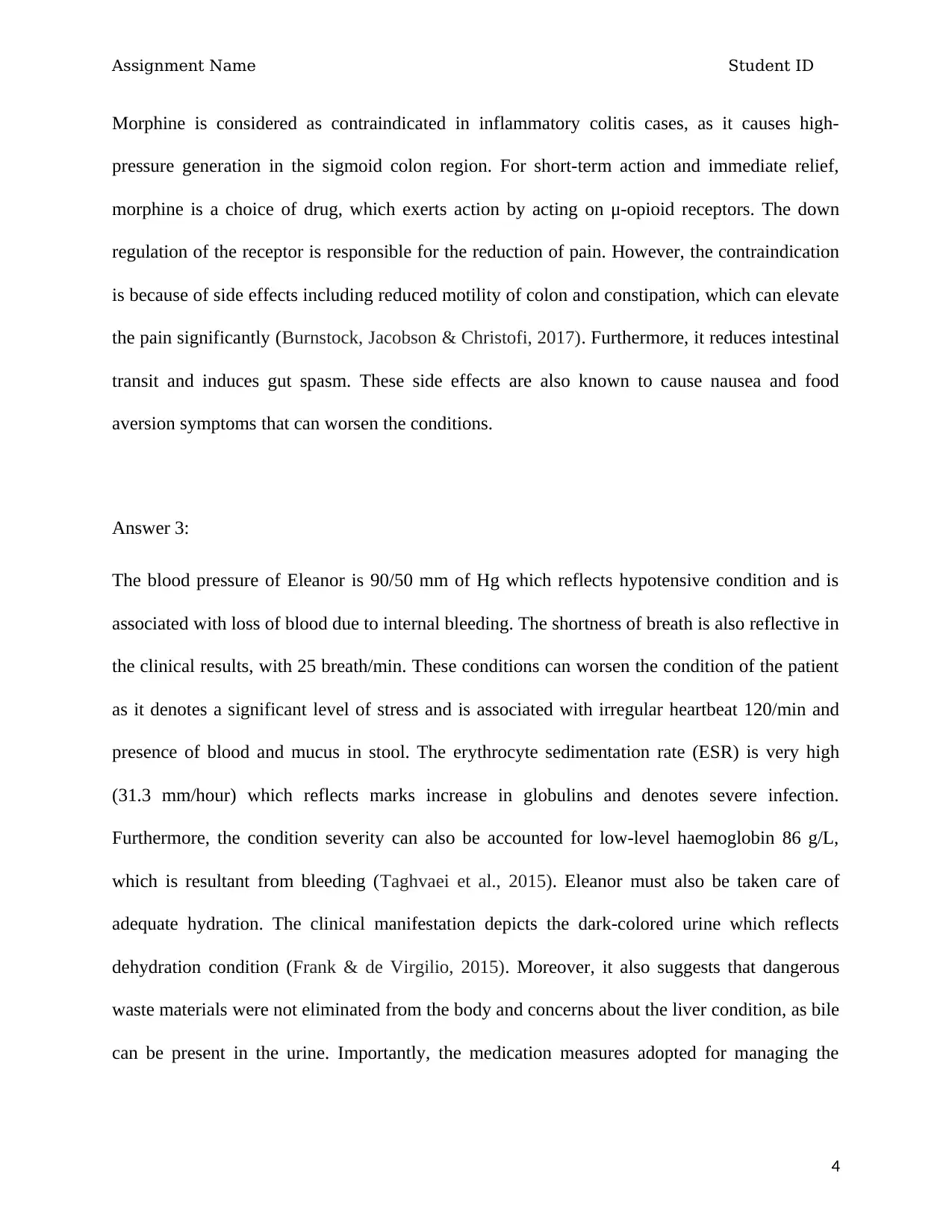
Assignment Name Student ID
Morphine is considered as contraindicated in inflammatory colitis cases, as it causes high-
pressure generation in the sigmoid colon region. For short-term action and immediate relief,
morphine is a choice of drug, which exerts action by acting on μ-opioid receptors. The down
regulation of the receptor is responsible for the reduction of pain. However, the contraindication
is because of side effects including reduced motility of colon and constipation, which can elevate
the pain significantly (Burnstock, Jacobson & Christofi, 2017). Furthermore, it reduces intestinal
transit and induces gut spasm. These side effects are also known to cause nausea and food
aversion symptoms that can worsen the conditions.
Answer 3:
The blood pressure of Eleanor is 90/50 mm of Hg which reflects hypotensive condition and is
associated with loss of blood due to internal bleeding. The shortness of breath is also reflective in
the clinical results, with 25 breath/min. These conditions can worsen the condition of the patient
as it denotes a significant level of stress and is associated with irregular heartbeat 120/min and
presence of blood and mucus in stool. The erythrocyte sedimentation rate (ESR) is very high
(31.3 mm/hour) which reflects marks increase in globulins and denotes severe infection.
Furthermore, the condition severity can also be accounted for low-level haemoglobin 86 g/L,
which is resultant from bleeding (Taghvaei et al., 2015). Eleanor must also be taken care of
adequate hydration. The clinical manifestation depicts the dark-colored urine which reflects
dehydration condition (Frank & de Virgilio, 2015). Moreover, it also suggests that dangerous
waste materials were not eliminated from the body and concerns about the liver condition, as bile
can be present in the urine. Importantly, the medication measures adopted for managing the
4
Morphine is considered as contraindicated in inflammatory colitis cases, as it causes high-
pressure generation in the sigmoid colon region. For short-term action and immediate relief,
morphine is a choice of drug, which exerts action by acting on μ-opioid receptors. The down
regulation of the receptor is responsible for the reduction of pain. However, the contraindication
is because of side effects including reduced motility of colon and constipation, which can elevate
the pain significantly (Burnstock, Jacobson & Christofi, 2017). Furthermore, it reduces intestinal
transit and induces gut spasm. These side effects are also known to cause nausea and food
aversion symptoms that can worsen the conditions.
Answer 3:
The blood pressure of Eleanor is 90/50 mm of Hg which reflects hypotensive condition and is
associated with loss of blood due to internal bleeding. The shortness of breath is also reflective in
the clinical results, with 25 breath/min. These conditions can worsen the condition of the patient
as it denotes a significant level of stress and is associated with irregular heartbeat 120/min and
presence of blood and mucus in stool. The erythrocyte sedimentation rate (ESR) is very high
(31.3 mm/hour) which reflects marks increase in globulins and denotes severe infection.
Furthermore, the condition severity can also be accounted for low-level haemoglobin 86 g/L,
which is resultant from bleeding (Taghvaei et al., 2015). Eleanor must also be taken care of
adequate hydration. The clinical manifestation depicts the dark-colored urine which reflects
dehydration condition (Frank & de Virgilio, 2015). Moreover, it also suggests that dangerous
waste materials were not eliminated from the body and concerns about the liver condition, as bile
can be present in the urine. Importantly, the medication measures adopted for managing the
4
Paraphrase This Document
Need a fresh take? Get an instant paraphrase of this document with our AI Paraphraser
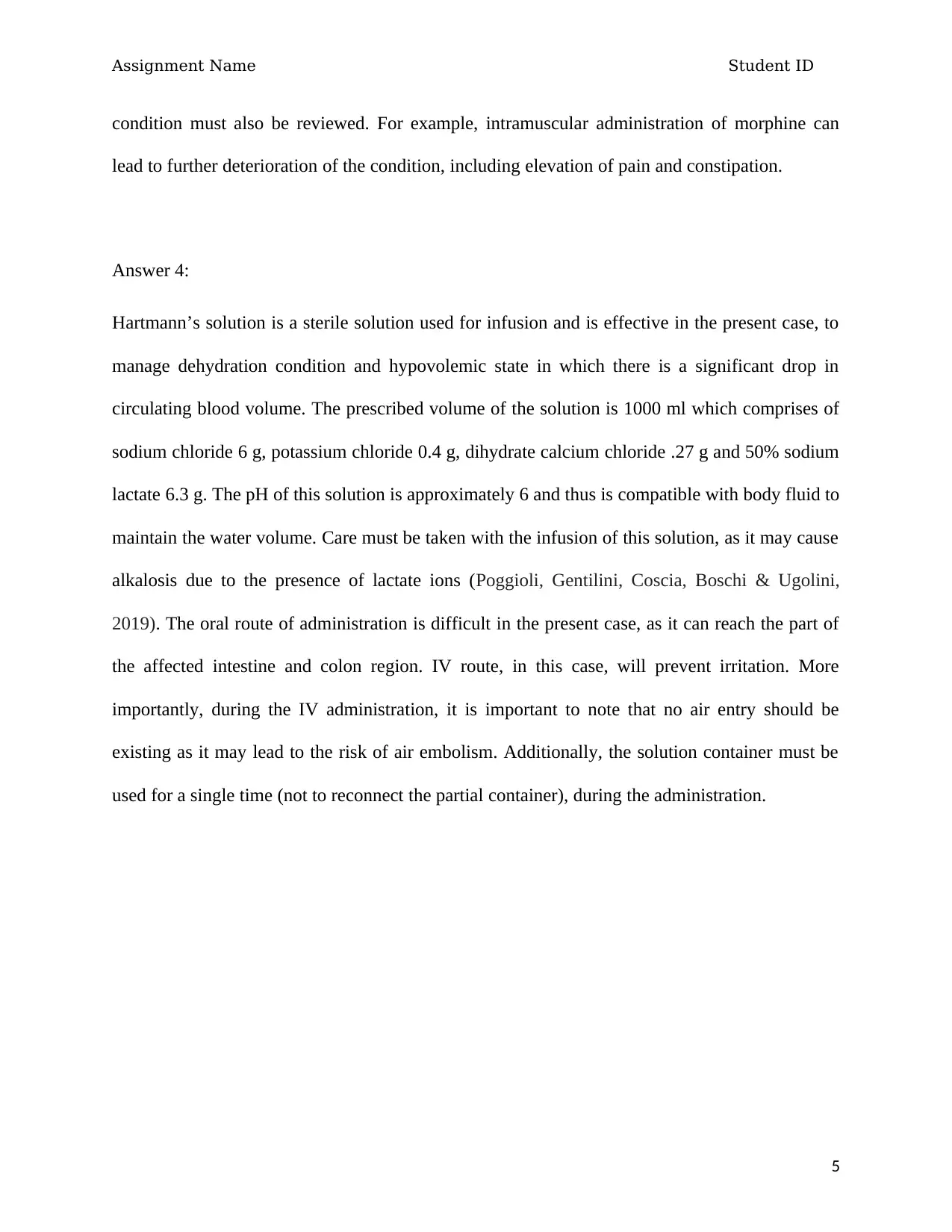
Assignment Name Student ID
condition must also be reviewed. For example, intramuscular administration of morphine can
lead to further deterioration of the condition, including elevation of pain and constipation.
Answer 4:
Hartmann’s solution is a sterile solution used for infusion and is effective in the present case, to
manage dehydration condition and hypovolemic state in which there is a significant drop in
circulating blood volume. The prescribed volume of the solution is 1000 ml which comprises of
sodium chloride 6 g, potassium chloride 0.4 g, dihydrate calcium chloride .27 g and 50% sodium
lactate 6.3 g. The pH of this solution is approximately 6 and thus is compatible with body fluid to
maintain the water volume. Care must be taken with the infusion of this solution, as it may cause
alkalosis due to the presence of lactate ions (Poggioli, Gentilini, Coscia, Boschi & Ugolini,
2019). The oral route of administration is difficult in the present case, as it can reach the part of
the affected intestine and colon region. IV route, in this case, will prevent irritation. More
importantly, during the IV administration, it is important to note that no air entry should be
existing as it may lead to the risk of air embolism. Additionally, the solution container must be
used for a single time (not to reconnect the partial container), during the administration.
5
condition must also be reviewed. For example, intramuscular administration of morphine can
lead to further deterioration of the condition, including elevation of pain and constipation.
Answer 4:
Hartmann’s solution is a sterile solution used for infusion and is effective in the present case, to
manage dehydration condition and hypovolemic state in which there is a significant drop in
circulating blood volume. The prescribed volume of the solution is 1000 ml which comprises of
sodium chloride 6 g, potassium chloride 0.4 g, dihydrate calcium chloride .27 g and 50% sodium
lactate 6.3 g. The pH of this solution is approximately 6 and thus is compatible with body fluid to
maintain the water volume. Care must be taken with the infusion of this solution, as it may cause
alkalosis due to the presence of lactate ions (Poggioli, Gentilini, Coscia, Boschi & Ugolini,
2019). The oral route of administration is difficult in the present case, as it can reach the part of
the affected intestine and colon region. IV route, in this case, will prevent irritation. More
importantly, during the IV administration, it is important to note that no air entry should be
existing as it may lead to the risk of air embolism. Additionally, the solution container must be
used for a single time (not to reconnect the partial container), during the administration.
5
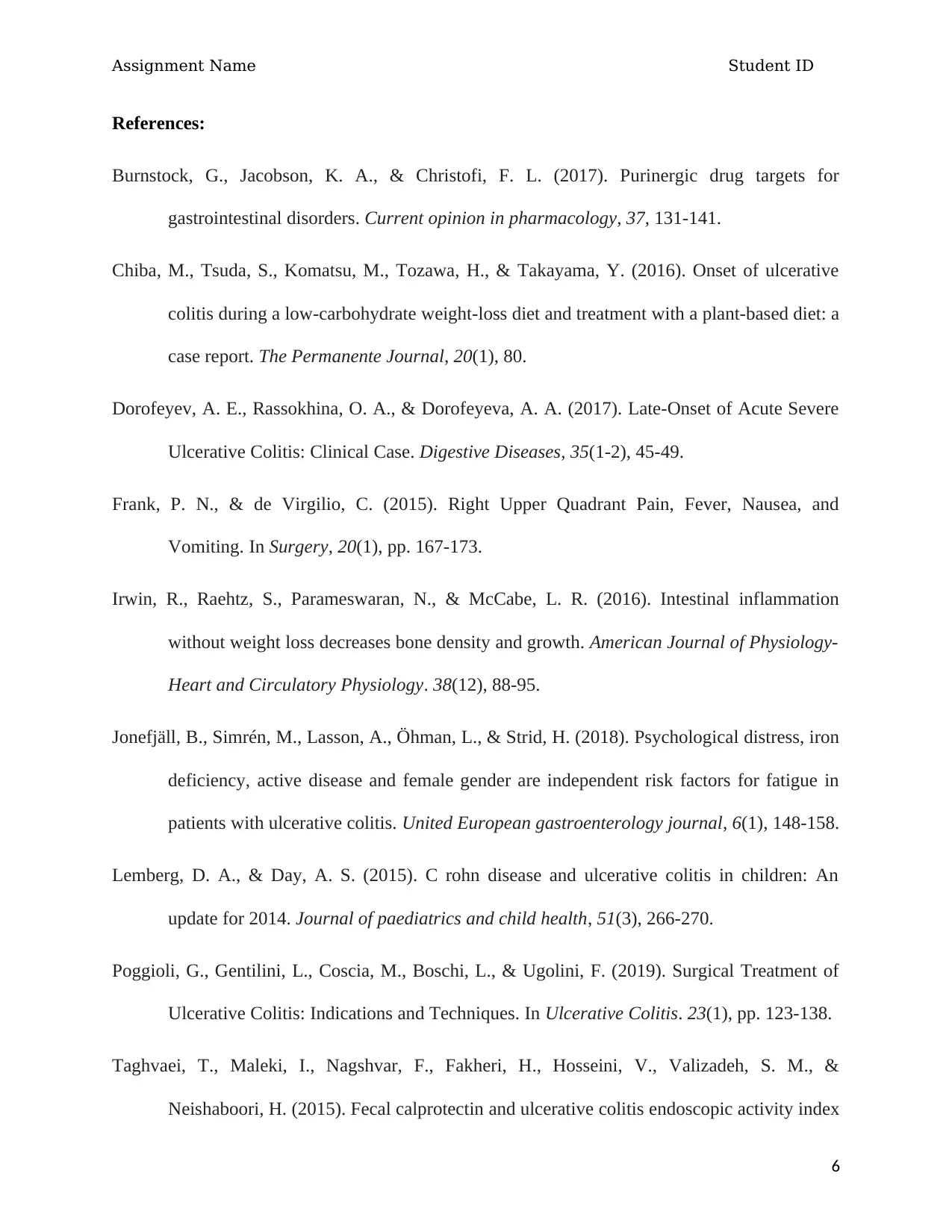
Assignment Name Student ID
References:
Burnstock, G., Jacobson, K. A., & Christofi, F. L. (2017). Purinergic drug targets for
gastrointestinal disorders. Current opinion in pharmacology, 37, 131-141.
Chiba, M., Tsuda, S., Komatsu, M., Tozawa, H., & Takayama, Y. (2016). Onset of ulcerative
colitis during a low-carbohydrate weight-loss diet and treatment with a plant-based diet: a
case report. The Permanente Journal, 20(1), 80.
Dorofeyev, A. E., Rassokhina, O. A., & Dorofeyeva, A. A. (2017). Late-Onset of Acute Severe
Ulcerative Colitis: Clinical Case. Digestive Diseases, 35(1-2), 45-49.
Frank, P. N., & de Virgilio, C. (2015). Right Upper Quadrant Pain, Fever, Nausea, and
Vomiting. In Surgery, 20(1), pp. 167-173.
Irwin, R., Raehtz, S., Parameswaran, N., & McCabe, L. R. (2016). Intestinal inflammation
without weight loss decreases bone density and growth. American Journal of Physiology-
Heart and Circulatory Physiology. 38(12), 88-95.
Jonefjäll, B., Simrén, M., Lasson, A., Öhman, L., & Strid, H. (2018). Psychological distress, iron
deficiency, active disease and female gender are independent risk factors for fatigue in
patients with ulcerative colitis. United European gastroenterology journal, 6(1), 148-158.
Lemberg, D. A., & Day, A. S. (2015). C rohn disease and ulcerative colitis in children: An
update for 2014. Journal of paediatrics and child health, 51(3), 266-270.
Poggioli, G., Gentilini, L., Coscia, M., Boschi, L., & Ugolini, F. (2019). Surgical Treatment of
Ulcerative Colitis: Indications and Techniques. In Ulcerative Colitis. 23(1), pp. 123-138.
Taghvaei, T., Maleki, I., Nagshvar, F., Fakheri, H., Hosseini, V., Valizadeh, S. M., &
Neishaboori, H. (2015). Fecal calprotectin and ulcerative colitis endoscopic activity index
6
References:
Burnstock, G., Jacobson, K. A., & Christofi, F. L. (2017). Purinergic drug targets for
gastrointestinal disorders. Current opinion in pharmacology, 37, 131-141.
Chiba, M., Tsuda, S., Komatsu, M., Tozawa, H., & Takayama, Y. (2016). Onset of ulcerative
colitis during a low-carbohydrate weight-loss diet and treatment with a plant-based diet: a
case report. The Permanente Journal, 20(1), 80.
Dorofeyev, A. E., Rassokhina, O. A., & Dorofeyeva, A. A. (2017). Late-Onset of Acute Severe
Ulcerative Colitis: Clinical Case. Digestive Diseases, 35(1-2), 45-49.
Frank, P. N., & de Virgilio, C. (2015). Right Upper Quadrant Pain, Fever, Nausea, and
Vomiting. In Surgery, 20(1), pp. 167-173.
Irwin, R., Raehtz, S., Parameswaran, N., & McCabe, L. R. (2016). Intestinal inflammation
without weight loss decreases bone density and growth. American Journal of Physiology-
Heart and Circulatory Physiology. 38(12), 88-95.
Jonefjäll, B., Simrén, M., Lasson, A., Öhman, L., & Strid, H. (2018). Psychological distress, iron
deficiency, active disease and female gender are independent risk factors for fatigue in
patients with ulcerative colitis. United European gastroenterology journal, 6(1), 148-158.
Lemberg, D. A., & Day, A. S. (2015). C rohn disease and ulcerative colitis in children: An
update for 2014. Journal of paediatrics and child health, 51(3), 266-270.
Poggioli, G., Gentilini, L., Coscia, M., Boschi, L., & Ugolini, F. (2019). Surgical Treatment of
Ulcerative Colitis: Indications and Techniques. In Ulcerative Colitis. 23(1), pp. 123-138.
Taghvaei, T., Maleki, I., Nagshvar, F., Fakheri, H., Hosseini, V., Valizadeh, S. M., &
Neishaboori, H. (2015). Fecal calprotectin and ulcerative colitis endoscopic activity index
6
⊘ This is a preview!⊘
Do you want full access?
Subscribe today to unlock all pages.

Trusted by 1+ million students worldwide
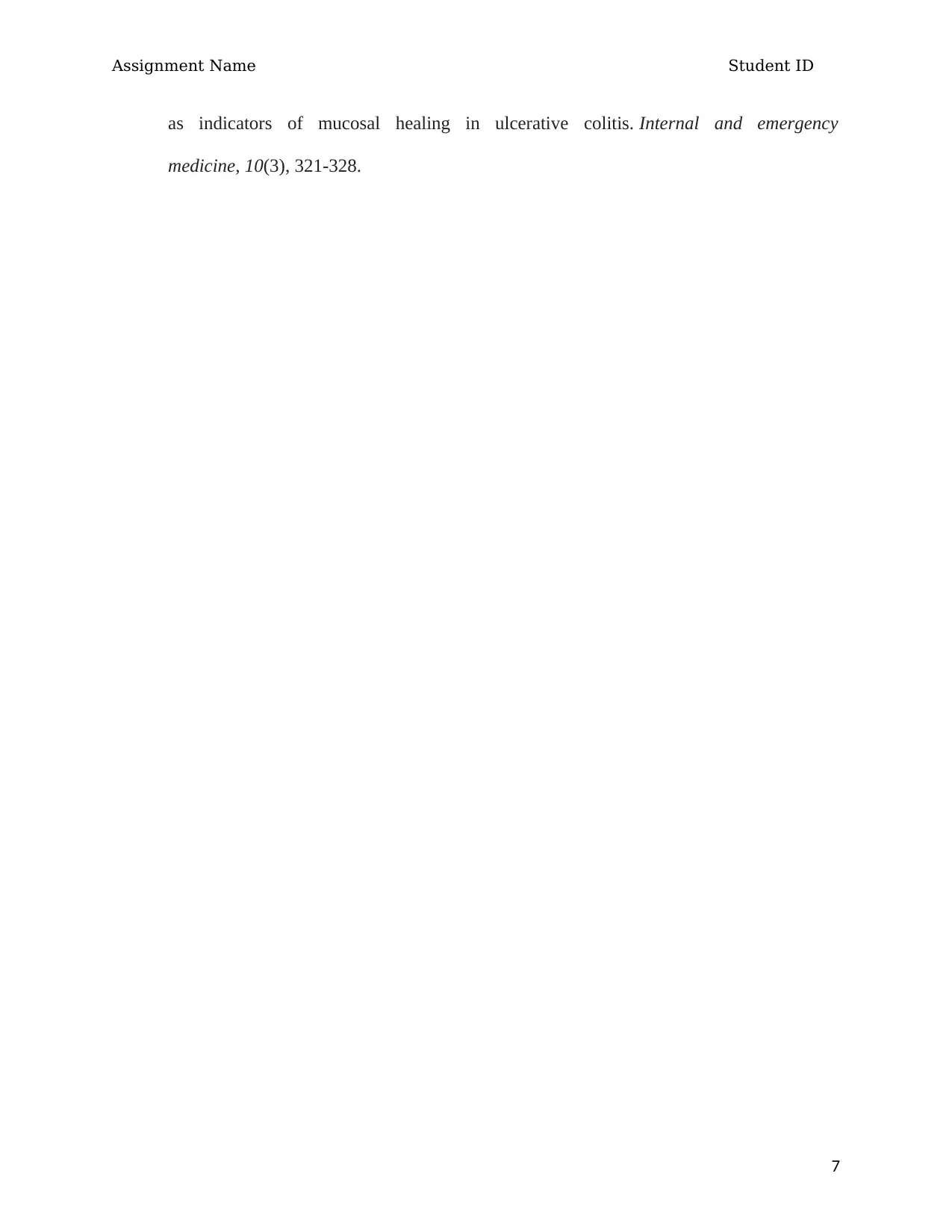
Assignment Name Student ID
as indicators of mucosal healing in ulcerative colitis. Internal and emergency
medicine, 10(3), 321-328.
7
as indicators of mucosal healing in ulcerative colitis. Internal and emergency
medicine, 10(3), 321-328.
7
1 out of 7
Related Documents
Your All-in-One AI-Powered Toolkit for Academic Success.
+13062052269
info@desklib.com
Available 24*7 on WhatsApp / Email
![[object Object]](/_next/static/media/star-bottom.7253800d.svg)
Unlock your academic potential
Copyright © 2020–2025 A2Z Services. All Rights Reserved. Developed and managed by ZUCOL.





